Phase transitions in video games and game balance
A phase transition occurs when the system crosses the line separating the two phases [ 1 ]. For water and ice it is 0 ° C ( if we discard the influence of atmospheric pressure and other factors ). In addition to phase transitions in thermodynamics, phase transitions can also be distinguished for video games.
In games and near-game fields, phase transitions are much less studied and often cannot boast of rigorous scientific evidence. This effect is often referred to as “critical mass gain”.
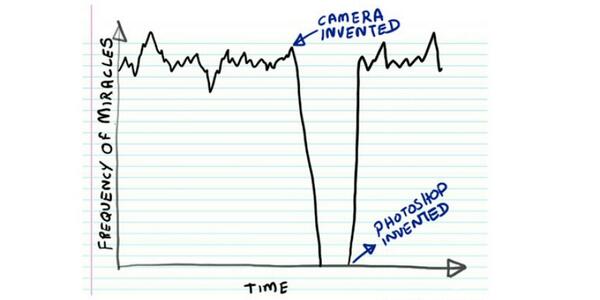 Picture Frequency of miracles [ 2 ]
Picture Frequency of miracles [ 2 ]
Next, we will consider illustrative examples of phase transitions and possible ways of working with them.
The phase transitions are amazing and beautiful with their abrupt state changes when certain constant threshold values are reached for the controlling factors. And it does not matter how these factors reached the threshold values: with a gradual uniform change in values or abrupt irregular jumps, the threshold values of the phase transition will be the same. I have this effect is a real delight. And if I got used to the glaciation, melting and boiling from childhood and did not pay attention to it, then to less obvious examples I have deeply warm feelings.
The whole dramatic effect of unknown / undetected phase transitions is manifested due to a number of their features:
Imagine a standard melee warrior of the 1st level with a damage of 50 units and a survivability of 50 units. He fights with the enemies around him, for example, with a caterpillar with damage of 10 units with a survivability margin of 72 units. Suppose that a warrior always attacks first, and a caterpillar attacks in response.
The log of such battles can be represented as follows:
Suppose with each new level a warrior receives a bonus of 5 damage and 5 survivability. On the basis of these data, it is possible to construct a graph of the number of killed crawlers before the need for treatment (loss of time and resources):
 Dependence of the number of killed gossenozhek to the need for treatment
Dependence of the number of killed gossenozhek to the need for treatment
That is, from the 6th level (when he will have 75 damage) the player can kill the crawlers with more than twice as fast as stop taking damage from them. Such an imbalance is quite easy to smooth out or eliminate when the developer is dealing with 2-able characters. When these characters become many dozens and each has a dozen different types of attacks, the developer will certainly face an imbalance in various combinations. A twist of some parameters will lead to the emergence of new super characters.
For example:
The South Park animated series “Make love, not Warcraft,” [ 3 ], where the main characters were pumped on boars dying with one blow.
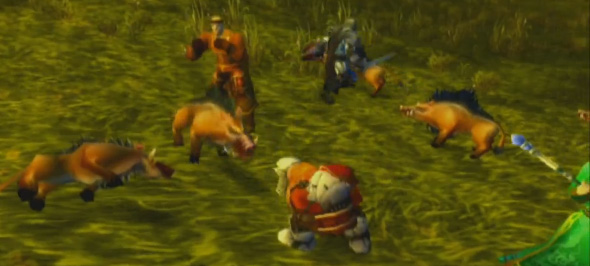 Boar extermination - South Park
Boar extermination - South Park
At the moment, came up with several ways to combat this problem:
Dominant strategy is a situation in which one of the strategies of a player gives a greater gain than the other for any actions of his opponents [ 8 ]. The emergence of dominant strategies is inevitable, but developers can weaken them, bringing the gameplay to a more balanced state.
Examples of phase transitions in dominant strategies:
In conclusion, I would like to give an excellent quote from the article “Level 16: Game Balance” by Ian Schreiber [ 13 ] (in general, the whole site contains a very interesting series of articles about game balance from different points of view) .
In games and near-game fields, phase transitions are much less studied and often cannot boast of rigorous scientific evidence. This effect is often referred to as “critical mass gain”.

Next, we will consider illustrative examples of phase transitions and possible ways of working with them.
The phase transitions are amazing and beautiful with their abrupt state changes when certain constant threshold values are reached for the controlling factors. And it does not matter how these factors reached the threshold values: with a gradual uniform change in values or abrupt irregular jumps, the threshold values of the phase transition will be the same. I have this effect is a real delight. And if I got used to the glaciation, melting and boiling from childhood and did not pay attention to it, then to less obvious examples I have deeply warm feelings.
The whole dramatic effect of unknown / undetected phase transitions is manifested due to a number of their features:
- The effect becomes noticeable rather late, when the damage has already been done, and a lot of angry reviews from grateful fans have appeared on the forums: “they did it on their knees”; "Krivoruky developers"; "Spoiled everything."
- The transition from one phase to another occurs "instantly" after a small change in characteristics. That is, for a long time, linear changes in the characteristics affect the whole game linearly and balancedly, but after another increase, the player suddenly gets an invincible hero or super-complicated boss. And the owners of the game get a bored player gone or tons of hate on social networks.
The growth of the main characteristics of the fighting characters
Imagine a standard melee warrior of the 1st level with a damage of 50 units and a survivability of 50 units. He fights with the enemies around him, for example, with a caterpillar with damage of 10 units with a survivability margin of 72 units. Suppose that a warrior always attacks first, and a caterpillar attacks in response.
The log of such battles can be represented as follows:
1) Warrior hp (50), dmg (50) attacks Huckle no. 1 hp (72) => hp (22), dmg (10)Thus, the warrior will have time to destroy 4 gosenozhek, after which he will need treatment.
2) Huntle no.1 hp (22), dmg (10) attacks Warrior hp (50 ) => hp (40), dmg (50)
3) Warrior hp (40), dmg (50) attacks Gusenozhk No. 1 hp (22) => hp (0), dmg (10)
4) Warrior hp (40) , dmg (50) attacks Gusenozh No. 2 hp (72) => hp (22), dmg (10)
5) Caterpillar No. 2 hp (22), dmg (10) attacks Warrior hp (40) => hp (30) , dmg (50)
6) Warrior hp (30), dmg (50) attacks Huckle no. 2 hp (22) => hp (0), dmg (10)
7) Warrior hp (30), dmg (50) and so The trap # 3 hp (72) => hp (22), dmg (10)
8) The trap # 3 hp (22), dmg (10) attacks the Warrior hp (30) => hp (20), dmg (50)
9 ) Warrior hp (20), dmg (50) attacks Gusenozhk No. 3 hp (22) => hp (0), dmg (10)
10) Warrior hp (20), dmg (50) attacks Gusenozhku 4 hp (72) => hp (22), dmg (10)
11) Crawler # 4 hp (22), dmg (10) attacks Warrior hp (20) => hp (10), dmg (50)
12) Warrior hp (10), dmg (50) attacks Crawler # 4 hp (22 ) => hp (0), dmg (10)
13) Warrior hp (10), dmg (50) retreats for treatment
Suppose with each new level a warrior receives a bonus of 5 damage and 5 survivability. On the basis of these data, it is possible to construct a graph of the number of killed crawlers before the need for treatment (loss of time and resources):

That is, from the 6th level (when he will have 75 damage) the player can kill the crawlers with more than twice as fast as stop taking damage from them. Such an imbalance is quite easy to smooth out or eliminate when the developer is dealing with 2-able characters. When these characters become many dozens and each has a dozen different types of attacks, the developer will certainly face an imbalance in various combinations. A twist of some parameters will lead to the emergence of new super characters.
For example:
The South Park animated series “Make love, not Warcraft,” [ 3 ], where the main characters were pumped on boars dying with one blow.

At the moment, came up with several ways to combat this problem:
- Creating vulnerabilities of different classes of characters like rock-paper-scissors , where it is critical (collisions with real players), and where it is uncritical (for example, in the case of NPC) - is simply ignored. For example, a magician always defeats a warrior, a warrior always defeats a thief, a thief always defeats a magician. Or system: water, fire, earth:Elemental rock-paper-scissors in Pokémon [ 4 ]
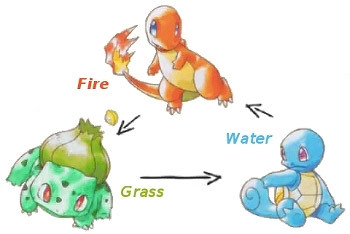
This approach gives a certain certainty that even with a broken lazy balance, an unreasonably strong character will always have his own Achilles heel. - Increase the strength of opponents in proportion to the strength of the player . So, for example, come in the games Oblivion and Skyrim. Although Skyrim did it not so clumsy and almost imperceptibly. But Oblivion received a fair share of “people's love” for its auto-reliance:Auto-leasing in Skyrim & Oblivion [ 5 ]

- Hide the problem with fences restrictions . This is perhaps the most lazy approach. It lies in the fact that the imbalance can be hidden if you block access to it. Thus, restrictions are used on the minimum and maximum level of the hero on: use of equipment; access to locations and quests; the inability to attack another player with a significant difference in levels.Limiting locations to hero levels in Darkest Dungeon [ 6 ]
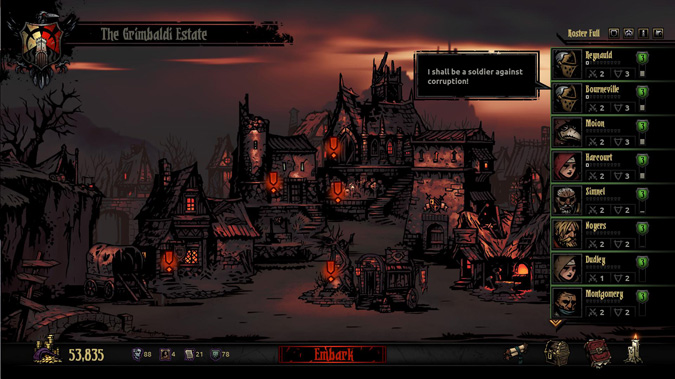
- Depreciation . The method consists in the fact that for easily accessible achievements a minimum reward is given. For example, for defeating Gusenozhka, warriors of the 6th level and above stop gaining experience. Or an older way: an exponential increase in the required amount of experience for levelap. Or both of these approaches at once. Thus, the use of imbalance loses all meaning for the player. This method is used, for example, in games Newerwinter Nigts 2, here is a table of the required experience to enhance:The table of experience required for upgrading to Neverwinter Nights 2 [ 7 ]
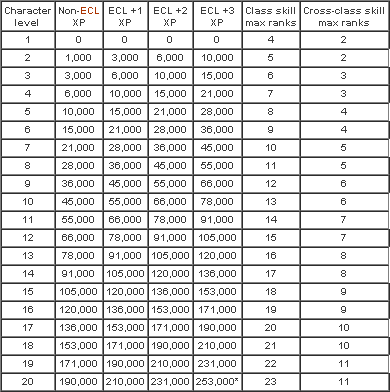
There are hardly many willing to destroy 4,750 goblins with 4 experience points in order to get a promotion from level 19 to level 20.
Search for dominant strategy
Dominant strategy is a situation in which one of the strategies of a player gives a greater gain than the other for any actions of his opponents [ 8 ]. The emergence of dominant strategies is inevitable, but developers can weaken them, bringing the gameplay to a more balanced state.
Examples of phase transitions in dominant strategies:
- 1. Hearthstone [ 9 ]. This is a multiplayer card game from Blizzard, in which strategies with “endless damage” constantly arise. One of the most striking examples is the "infinite" generation of fireballs for 0 mana.
The phase transition line here is a combination of laid out cards:
- one Archmage Antonidas, who puts a Fireball in his hand for 4 mana after the player plays any spell;
- Four pupils magician, which reduce the cost of spells by 1 for each student;
- any spell to start generating fireball creation.
Hearthstone - a combo of endless fireballs for 0 mana [ 10 ].
The only limitation of such a strategy becomes time, during which it is necessary to have time to lay out the strategy and finish off the enemy, which does not allow to call this strategy completely unlimited. Game developers periodically cover up the possibility of the execution of this strategy, but it is revived with enviable stubbornness with the help of new combinations. This strategy initially broke the game balance, but with the help of improvements of developers it became quite difficult to implement, so the balance was restored (using this strategy simply lose before they can implement it). - 2. Slay the Spire [ 11 ]. This is a roguelike-like single-player card game. In it, as in Hearthstone, you can create endless strategies. The phase transition line in such strategies is a stable combination of cards throughout the player's deck - when there are all the necessary cards and there are no extra ones that could interrupt the chain of endless repetition of the winning strategy.
Slay the Spire - a steady, endless combo of 2 cards [ 12 ]
Players have discovered several similar strategies. There is most likely no broken balance, because the entire game design is based on creating such super strategies so that you can win in the end. In addition, the randomness of the generated environment prevents the collection of such combinations on an ongoing basis.
Conclusion
In conclusion, I would like to give an excellent quote from the article “Level 16: Game Balance” by Ian Schreiber [ 13 ] (in general, the whole site contains a very interesting series of articles about game balance from different points of view) .
The Role of Balance - the original
Role of by Balance of The
with In up my early days as with the a designer, I of WAS very passionate about game balance. “This is a fun game” was my mantra. I'm sure I’ve got them right now. Such is the privilege of youth.
While I still believe balance is important and a key skill for any game designer, I now take a more moderate line. I have seen some games that are fun in spite of being unbalanced. I’ve seen other games that are fun specifically because they are intentionally unbalanced. I have seen some games that have done astoundingly well in the marketplace, despite having egregious imbalances. These are rare and special cases, to be sure. But let this serve as a reminder to you that the techniques and concepts discussed today should never take priority over the ultimate design goals for your game. Let these techniques be your tools, not your master.
with In up my early days as with the a designer, I of WAS very passionate about game balance. “This is a fun game” was my mantra. I'm sure I’ve got them right now. Such is the privilege of youth.
While I still believe balance is important and a key skill for any game designer, I now take a more moderate line. I have seen some games that are fun in spite of being unbalanced. I’ve seen other games that are fun specifically because they are intentionally unbalanced. I have seen some games that have done astoundingly well in the marketplace, despite having egregious imbalances. These are rare and special cases, to be sure. But let this serve as a reminder to you that the techniques and concepts discussed today should never take priority over the ultimate design goals for your game. Let these techniques be your tools, not your master.
The role of balance (translation)
In my early years as a game designer, I was completely uncompromising in terms of game balance. “An interesting game is a balanced game, and a balanced game is an interesting game,” was my mantra. I have no doubt that I irritated many of my senior colleagues with my ranting about the deficiencies in the balance in our games, and why we should correct them immediately. Ah, youthful maximalism.
Although I still believe that the ability to find balance is an important and key skill of any game designer, I now adhere to a more tolerant point of view. I met games that were interesting despite the fact that they were unbalanced. I met games that were interesting precisely because they deliberately upset the balance. I even met a few games that were surprisingly successful, despite the fact that there was just a glaring imbalance in the gameplay. Although it is worth noting that these are very rare and specific cases. So let it serve you as a reminder that all the methods and approaches I have voiced should not prevail over the main goals of your game. Let these approaches to achieve balance be your means, not the end.
Sources of literature
- Phase transition in thermodynamics
- Picture Frequency of miracles
- Series of the animated series South Park "Make love, not Warcraft'om"
- Elemental stone-scissors-paper in Pokemon
- AutoWatching in Skyrim & Oblivion
- Limit locations to hero levels in Darkest Dungeon
- The table of experience required to improve in Neverwinter Nights 2
- Dominant Strategy - Wikipedia
- Hearthstone official website
- Hearthstone - Combo of Infinite Fireballs - Youtube
- Slay the Spire
- Slay the Spire - steady endless combo of 2 cards
- Level 16: Game Balance and Ian Schreiber series of balance articles
